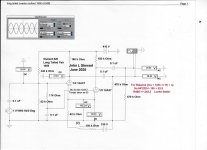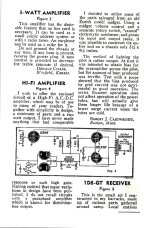Your TEK 310A is a very nice scope. I'm sure any of us would like to be the proud owner!
There was a slightly later TEK 310D in the lab that I used occasionally. the 'D' means it had a delay
line in the vertical channel so that the front edge of step function could be studied.
Which of the several vertical plugins are you using in your 5 inch CRT scopes are you using?
My recollection, the 'D' is the Differential version. When I escaped the research lab to join
HP in 1965 I never used any of those scopes again.
My answer is a diversion. Instead I will show why getting perfect balance is a waste of time.
Here are two simulations of the ordinary Mullard circuit, one the normal & another with a longer tail.
The longer tail makes an improvement that may be worth doing. It uses a negative power
supply, something I've done on all my PP builds for the last 30 yrs. Negative PS is very easy to do,
I'm surprised more people don't try it.
The usual fixes are a current mirror or an MJE340 transistor for the tail. So balance is very good.
But then we find the tubes in the power stage are often not matched well.
So back to driving the output stage with unequal drive, And a circuit to do that.
There was a slightly later TEK 310D in the lab that I used occasionally. the 'D' means it had a delay
line in the vertical channel so that the front edge of step function could be studied.
Which of the several vertical plugins are you using in your 5 inch CRT scopes are you using?
My recollection, the 'D' is the Differential version. When I escaped the research lab to join
HP in 1965 I never used any of those scopes again.
My answer is a diversion. Instead I will show why getting perfect balance is a waste of time.
Here are two simulations of the ordinary Mullard circuit, one the normal & another with a longer tail.
The longer tail makes an improvement that may be worth doing. It uses a negative power
supply, something I've done on all my PP builds for the last 30 yrs. Negative PS is very easy to do,
I'm surprised more people don't try it.
The usual fixes are a current mirror or an MJE340 transistor for the tail. So balance is very good.
But then we find the tubes in the power stage are often not matched well.
So back to driving the output stage with unequal drive, And a circuit to do that.
Attachments
MJE340 CCS samples:
https://atrad-audio.co.nz/turneraudio/www.turneraudio.com.au/Integrated5050.html
https://atrad-audio.co.nz/turneraudio/www.turneraudio.com.au/Integrated5050.html
For this project I'll try using LM317Ts as current sinks. I'm really curious to see how it will sound

Looks like you are intending to build a self inverting power stage,
many of which have appeared on this forum & in magazine articles the past.
.
And in various forms going back to at least WW2.
I did several experimental versions, all poor performers.
Many of the measurement results were posted here on DIY.👎🙁
many of which have appeared on this forum & in magazine articles the past.
.
And in various forms going back to at least WW2.
I did several experimental versions, all poor performers.
Many of the measurement results were posted here on DIY.👎🙁



